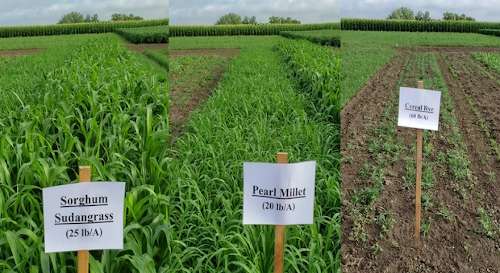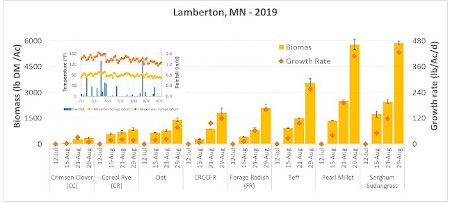By Liz Stahl and Axel Garcia y Garcia
When farmers are faced with a crop failure due to severe hail or excessive water, or conditions prevent planting in the first place, seeding cover crops on these acres can help control weeds and protect soil from erosion as well as provide other soil health benefits. A cover crop can also help reduce or prevent fallow syndrome from impacting crop yield the following year. See Reduce the risk of fallow syndrome with cover crops and How to prevent fallow syndrome in corn for more information.

Cover crops varied dramatically in the amount of biomass produced when seeded on July 12 at the SWROC, Lamberton. Cover crop and seeding rate are displayed. Photos were taken a month after seeding
Study background
In 2019 in response to an unprecedented level of prevent plant acres, a trial was initiated at the Southwest Research and Outreach Center in Lamberton to evaluate the performance of cover crops planted in the middle of July. At this time, the late planting window for corn and soybean for crop insurance purposes has passed and it is too late to realistically replant corn or soybean for grain yield. Cover crop species were selected based on factors such as the likelihood for successful establishment in mid-July, seed cost, seed availability, and recommendations from local suppliers.
Depending on what your goals are in planting a cover crop at this time, biomass production is a key indicator in the potential of a cover crop to smother out weeds, provide protection from wind and water erosion, and potentially provide other soil health benefits including additions to soil organic matter.
Seven species and a mixture were planted on July 12 with a four-row Penn State Interseeder that plants three rows of cover crop between the main crop rows:
- cereal rye
- crimson clover
- forage radish
- pearl millet
- sorghum sudangrass
- oat
- teff
- Mixture including cereal rye + crimson clover + forage radish)
Table 1 lists seeding rates and planting depth for each treatment. Seeding rates were determined using the Midwest Cover Crops Council-Cover Crop Decision Tool (http://mccc.msu.edu/covercroptool/covercroptool.php), previous experience, and recommendations from local suppliers. Treatments were planted in randomized blocks and replicated twice. To measure growth of the cover crops, biomass samples were collected on August 15, 21, and at termination on August 29.
Table 1. Seeding rate and depth of planting for cover crops planted July 12, 2019 at Lamberton.
| Cover crop | Seeding rate (#/ac) | Seeding depth (inches) |
|---|
| Cereal rye (CR) | 60 | 1/2 to 3/4 |
| Crimson clover (CC) | 16 | 1/8 to 1/4 |
| Forage radish (FR) | 12 | 1/4 to 1/2 |
| CRCCFR | CR=30; CC=8; FR=6 | 1/3 to 1/2 |
| Oat | 64 | 1 to 2 |
| Teff | 10 | 1/8 to 1/4 |
| Pearl millet | 20 | 1/2 to 3/4 |
| Sorghum sudangrass | 25 | 1/2 to 1-1/2 |
Results
Relatively wet and warm conditions facilitated quick emergence, which occurred July 15 and 16. A heavy rain partially compromised emergence, but most of the cover crop treatments recovered.
In around six weeks (48 days after seeding), sorghum sudangrass and pearl millet by far produced the most biomass, yielding on average 5880 lb DM/Ac and 5790 lb DM/Ac, respectively, followed by teff (3560 lb DM/Ac), and forage radish (2100 lb DM/Ac) (Figure 1). The 3-way mix (CRCCFR) and oat were next in biomass production, yielding 1830 lb DM/Ac and 1420 DM/Ac, respectively. Cereal rye and crimson clover produced the least amount of biomass of the cover crops evaluated, yielding 860 lb DM/Ac and 360 lb DM/Ac, respectively.

Figure 1. Biomass production and growth rate of cover crop treatments 34, 40, and 48 days after seeding at Lamberton, 2019. The inset graph shows the daily precipitation, minimum temperature and maximum temperature
Another way to look at the biomass production potential of a cover crop is its rate of growth. Rate of growth was determined by dividing the amount of biomass produced since the last sampling date (or since seeding for the initial sampling date) by the number of days between sampling dates (Figure 1).
Ground cover was most quickly achieved with sorghum sudangrass with a growth rate of 52 lb DM/Ac/day during the first 34 days after seeding. In contrast, the growth rate of crimson clover was the slowest at only 2 lb DM/Ac/day during this time. Sorghum sudangrass continued to have one of the fastest growth rates throughout the trial, along with pearl millet. The oats became infected with leaf rust, which may have affected growth and biomass production.
Caveats
The 2019 growing season was extraordinarily wet; frequent rainfall during the first week after seeding resulted in establishment issues, but cover crops in most plots recovered. It is important to note that sorghum sudangrass, pearl millet, and teff are considered warm-season grasses, thus expected to perform better when planted in mid-July compared to cool-season grasses such as cereal rye and oat. This project demonstrated that all the cover crops tested could be established mid-July, although dramatic differences in biomass production were observed.
All of the cover crops tested, except for cereal rye, would normally winter-kill, but since this was a pilot study, the cover crops were terminated August 29, 48 days after seeding, and the ground tilled. As a result, biomass could have been much higher by the end of the season. If left to grow, however, some of the cover crops may have gotten larger than one would want to manage and/or could potentially produce seed. This study was also conducted at just one site in 2019 with limited replication, so caution must be taken when interpreting the data.
Management issues a farmer needs to consider but this study was not able to address, include
- Cover crop termination needs and over-wintering potential
- Impact of any previously-applied herbicides
- Ability to graze the cover crop (check rotational restrictions of previously-applied herbicides)
- The potential management implications of cover crop surface residues on planting and stand establishment the following season.
Future
This trial is being repeated in 2020, with the cover crops being planted in larger blocks to allow for more data collection, and replicated four times to allow for sound statistical analysis. We are also appreciative of Albert Lea Seedhouse for supplying seed for the trial.
Source : umn.edu